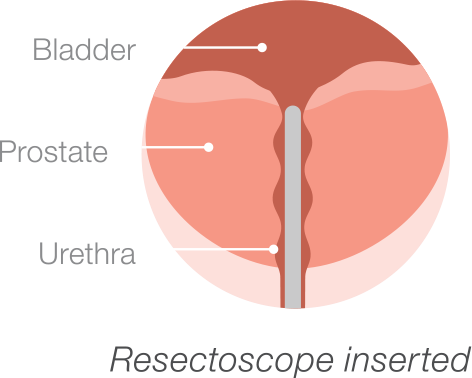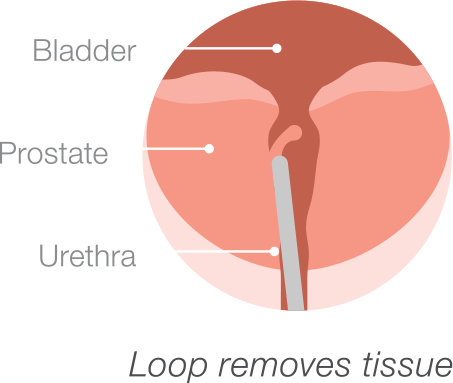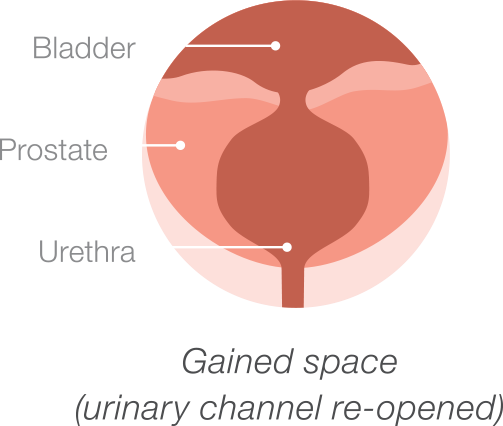The innovative Plasma technology gives your physician a superior level of precision and control to make your procedure as safe and effective as possible.
Why Plasma?
In contrast to other standard energy treatments that operate with high temperature, Plasma Vaporization & Resection uses low-temperature energy to safely remove BPH tissue. The gentle Plasma corona also minimizes damage to surrounding healthy tissue, leaving behind a smooth surface. Specifically, the Plasma-OvalButton™ has brought even more advancements to treating BPH. The Plasma-OvalButton™ gently vaporizes enlarged prostate tissue while the surgeon uses a unique hovering technique where there is virtually no direct contact between the device and prostate tissue. In addition to these clinical benefits, there may also be reduced side effects1, 2 including:
- Shorter procedure time
- Less bleeding
- Shorter catheterization time
- Quick return to normal activities
- Discontinuation of BPH medications
- Long-lasting results
What to expect before your Plasma Therapy procedure.
You will meet with your doctor to review the procedure and ask any questions you may have. Additionally, you’ll review the following information to determine if you are an ideal candidate for a Plasma procedure:
- Medical history
- Sensitivities or allergies to medicines, latex, iodine, tape, contrast dyes, or anesthesia
- List of all medications, vitamins, and supplements you are taking, including prescription and over-the-counter
- IPSS - International Prostate Symptom Score / BPH Quiz Results
Your doctor may recommend the following in advance of your Plasma Therapy procedure:
- Stop taking medication that may increase your risk of bleeding, including blood thinners like Warfarin or Clopidogrel, and non-prescription pain relievers such as aspirin or ibuprofen
- You may be asked not to eat or drink anything before the procedure
- If you smoke, stop as soon as possible to improve recovery and your overall health
- Arrange transportation ahead of time, as you will not be able to drive post-procedure
- Based on your medical condition, your healthcare provider may request other specific preparations.
During your Plasma Therapy procedure
For diagnosis of BPH, typically a surgeon will perform a Cystoscopy procedure, where an endoscope is inserted into the urethra through the opening at the end of the penis. It allows the surgeon to visually examine the urethra and the bladder for tumors, strictures and prostate enlargement.
During a Plasma Therapy procedure:
- The surgeon will reach the prostate by inserting a thin, tube-like instrument (resectoscope) through the urethra.
- A small camera with an illuminating light attached to the resectoscope allows the surgeon to see a magnified view of the prostate.
- A loop at the end of the instrument is passed along the enlarged prostatic tissue, removing obstructing tissue.
- The prostate is virtually “shelled out,” gaining space for normal urination and reducing problematic BPH symptoms.
- After the excess prostate tissue has been removed, the doctor will insert a soft, flexible tube called a catheter into your bladder to drain urine and to help you heal quickly.
TURP Procedure
Step by Step



Side Effects
Every medical treatment may have side effects. The same is true for the Plasma Therapy. The potential side effects are:
- Blood in the urine
- Cramping in the bladder or an urgent need to urinate
- Frequent urination, burning sensation
Following your Plasma Therapy procedure, you should contact your doctor immediately if you:
- See large amounts of blood in your urine
- Have a temperature in excess of 101° F
- Experience chills or shaking
The risk for serious complications depends on your medical condition and age. Ask your doctor what you should expect after surgery, as well as the potential risks that may occur with surgery.
Next Steps
Patients may have follow-up exams every 3 months during the first 2 years, every 6 months for the next 2-3 years, and once a year thereafter. Your doctor will discuss your post-procedural plan with you.
Returning to Normal Activity
A Plasma Therapy procedure typically allows you to return to your normal schedule quickly. The procedure itself can often be performed in less than 60 minutes on a day-case or outpatient basis, depending on your surgeon’s recommendation.
Data shows that some doctors have the ability to discharge 81.7% of patients on the same day of surgery.2 Talk with your doctor about resuming your regular activities.
Visit our Frequently Asked Questions page to learn more about the Plasma Therapy experience.
Plasma Therapy
Hear from the experts
Visit our Resource Hub to see how the procedure works and to see what experts are saying about Plasma Therapy.
View TestimonialsFAQs
Have questions about Plasma Therapy? Visit our FAQ page to get answers.
Plasma News
Learn about the latest news, clinical studies, and resources for Plasma Therapy.
The Plasma Patient
Plasma Therapy provides patients with shorter procedure times, a quick return to normal activities and long-lasting results. Find out if Olympus' Plasma technology is right for you.
Plasma Technology
The use of Plasma technology provides safe, long-lasting results for patients, while offering healthcare providers an easy-to-use solution.



